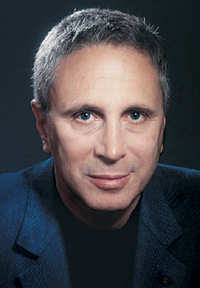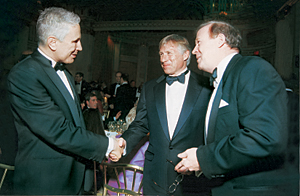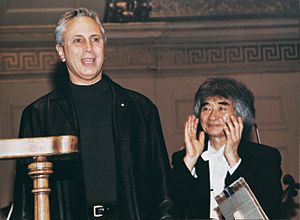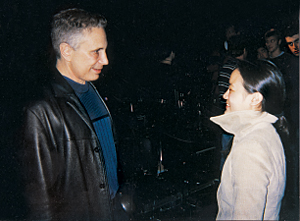
|
FEATURESweet MusicBY SARAH LORGE BUTLER ’95John Corigliano ’59 is widely acknowledged as one of the finest composers of his generation, and he has a Pulitzer and an Oscar to support that opinion. But he takes an unconventional view of where great art is coming from these days — and it’s not from where you’d expect. Corigliano says it’s not from the world of music and its great venues, such as Lincoln Center, Carnegie Hall or the Metropolitan Opera. Nor is it from the visual arts, the stage or the written page.
It’s coming, Corigliano maintains, from television. “I find the best art coming out of HBO,” he says. “I was watching Oz the other day. It’s terrifying. It’s violent and wild and hallucinatory and brilliant, because HBO has to reach people. No matter what it’s doing, whether it’s comic or horror, it knows it must reach an audience.” In a composing career that has spanned five decades, Corigliano has made reaching an audience his first priority. It’s not easy to do in classical music, as the composer must take the audience on a journey without the benefit of words or pictures. Corigliano is acutely aware of the challenge. “I’m one of those composers who believes that even the simplest piece in the world is hard for people to understand,” he says. “You can’t be too clear.” Nor is it easy to affect listeners when the musical establishment downplays the importance of connecting with the masses. Corigliano contends that his peers in classical composing are more interested in writing for each other, the musical elite, than for the folks who fill concert halls. A fellow composer once told Corigliano that he considers a concert to be a private communication through public means. “When he writes, he’s addressing his music to a few colleagues who are sitting in a 3,000-seat auditorium, like, maybe, 10 of them,” Corigliano says, the outrage rising in his voice. “He doesn’t care about the public. That kind of arrogance has led to a mess.” Corigliano has spun a highly successful career by putting a premium on the listener and sounding a dissonant note against the composers in the ivory tower. In 2001, he won a Pulitzer Prize for his Symphony No. 2; in 2000, he won an Oscar for his film score for The Red Violin. His Symphony No. 1 is one of the world’s most played contemporary works, having been performed by more than 125 orchestras. Corigliano also has published dozens of scores, from concertos to dances to an opera, The Ghosts of Versailles, which when it was staged in 1991 was the Metropolitan Opera’s first new opera in 25 years. In March, the College honored Corigliano with a 2003 John Jay Award for Distinguished Professional Achievement.
“John’s a composer who wants it to feel good for the player and wants it to work for the audience,” says renowned violinist Joshua Bell, who played the music to The Red Violin. “Some composers are so isolated, they don’t care about what anybody thinks, and they’re writing for this abstract reason. John will come out and say that music is for performance, he wants the audience to be satisfied — and he does that without pandering. I like John’s view.” It may say “composer” on Corigliano’s 1040, but he believes that to be successful in the profession, you need to be an architect first, with a design and a plan for every piece. Whether he’s working in his country home in Carmel, N.Y., or his apartment on the Upper West Side, before he gets to the smaller questions — filling in movements and inventing themes — he answers the big ones that influence a composition’s structure: Who is this piece for? What am I trying to do with it? How long is it going to be? So emphatic is Corigliano about the correct order of events in composition — structure first, details later — that he has multiple metaphors at the ready to describe the process. “Can you imagine writing an Agatha Christie novel, writing the entire book and getting to the last 50 pages and not knowing who the murderer was?” he asks. “If you’re decorating an apartment, you don’t start with a lamp or an ashtray. If you’re designing a building, you don’t start with the cornice.” That philosophy is all part of making his pieces understandable for the audience. It does not mean that Corigliano’s pieces lack complexity; in fact, they’re known for their intricacies and their difficulty and range of style. But his compositions take the listener on a journey, which ultimately makes music more satisfying for the audience and explains his appeal. “I’ve heard plenty of pieces in which any moment of it is pretty or interesting,” Corigliano says. “But after 10 or 15 minutes, I am bored, because it doesn’t add up to anything. “When you talk about what you do, you do each piece differently, based on the architecture that you build. But you build something, and then you find the music. It can be very adventurous, very wild, but it has purpose.”
It’s a system that Corigliano impresses upon his composing students at Lehman College, where he holds the title Distinguished Professor of Music, and Juilliard, where he has been on the music division faculty since 1991, teaching composition one-on-one to students. “It’s nice to talk to somebody who says, ‘Chill out, don’t start writing a theme for a piece you don’t understand yet,’” says Mason Bates ’00, a composer who studied with Corigliano at Juilliard. “He would say, ‘Tell me in words what this piece is about. What does it mean to you, and what do you want to communicate?’ It means a lot to a composer to think about that. John told me, ‘You have a good ear, you have good ideas, but you need to think about this entire piece before you start banging away.’ With John, it’s about imagining a whole space before you begin.” For Corigliano, that usually means envisioning an entirely new structure. Using pre-existing symphonic forms is like “Levittown,” he says — an easy way to fit your ideas into “prefabricated housing.” His refusal to take the easy route is a reflection of the exacting standards to which he holds himself, as well as his capacity for originality and inventiveness. “He’s hard on himself,” says Norman Ryan, Corigliano’s manager at music publisher G. Schirmer. “For years, he shied away from writing a symphony because he thought, ‘What new do I have to add to that form?’ It wasn’t until he was about 55 that he wrote his first symphony. He only felt he could do it if he had something important to contribute.” Corigliano grew up in Brooklyn. His mother was
a pianist who never played in public, his father,
a violinist in what is one of the music world’s
most visible and pressure-packed roles: concertmaster
of the New York Philharmonic. Watching his father
sweat out But it didn’t diminish Corigliano’s enthusiasm for music. He grew up with the 108 members of the New York Philharmonic as his extended family, and later wrote his 1977 clarinet concerto as an elegy for his father and a tribute to the players in the orchestra. Corigliano was drawn to composing, in part, he says, “because my parents didn’t want me to get into music, and especially composing.” As a young man, Corigliano says he was tense and hyper-energetic. Columbia was a logical, almost inevitable choice for him — a top university with a strong music program in New York City. Even as a college student, he found himself resisting the prevailing view of composing as a scholarly exercise to be understood only by a select few. That he’s still working in the minority, 40 years later, gives Corigliano a rather pessimistic view of the state of classical music. “One of the problems with concert music is this lack-of-future feeling,” he says, the idea that it is “an art form that’s dying in front of our eyes. And I think a lot of it is because classical music has ceased to have an active contemporary life. Presenters of classical music have relied on those old pieces to be the only diet.” The reasons, he says, are plentiful. When composers don’t try to engage their audience, the audience has trouble understanding and enjoying the compositions. But most audiences are afraid to object. “They think, ‘Well, I don’t know anything,’” Corigliano says. “And the critic usually says, ‘It’s wonderful,’ and the public feels foolish. They leave classical music and find musical art in pop, folk, rock, rap — something that relates to them.” The economics of the profession don’t help
matters, either. Orchestras have less and less rehearsal
time. Musicians should see the music well in advance
of a performance, but they often don’t —
the standard is for an orchestra to start rehearsing
a piece on Tuesday for a Thursday performance, Corigliano
says. It may have three or four rehearsals, but
that rehearsal time is divided among all the pieces
on the program. Corigliano attends rehearsals, but
his music is difficult, and he often feels it’s
only by the second or third performance that the
players really start to get it. By then, it’s
too late — they’ve already begun rehearsing
for the next program. Such abundant cause for frustration has motivated Corigliano to do whatever he can to champion his music. He gives frequent pre-concert lectures and finds audiences starving for the insights a composer can share. He is devoted to his students and impresses upon them the importance of representing the profession and living the life of a composer. “When I was first studying with him, he seemed to think I was something akin to Woody Allen, kind of neurotic,” Bates recalls. “He said, ‘You might think it’s kind of cutesy for a composer to be a person who can’t speak and then when his music is played, that’s when he speaks to the world. But in reality, you need to put the most professional face on your music that you can.’” The job, Bates says, doesn’t end when you put the double bar line on a piece; you need to be an advocate for your music on every level.
For Corigliano, every time there is an audience, there is a chance to educate on contemporary composing. The Academy Awards — with a television audience of millions — proved no exception. Often the most popular movie of a given year takes home the Oscar for best original score. In 2000, the big winner was American Beauty. But it did not win for best score; that honor went to The Red Violin. When presenters Charlize Theron and Keanu Reeves announced Corigliano’s name, the camera captured a look of amazement on his face. He stood up from his sixth-row seat, let the air escape from his lungs, and paused in the aisle momentarily, fist at his heart. On stage, he cradled the statuette in the crook of his arm, but he seized the opportunity to offer a nugget about composing: “I didn’t think I was going to be up here, and I’m really speechless,” he said. “But I just want to tell you, thanks so much. You know, I’m from another world, of classical music, and when I write my symphonies and my concertos, it’s a very lonely profession. One thing I’ve learned about film writing is how communal it is. And the reason people give thanks is because there are so many people who had so much to do with this film and with the music.” He thanked the director, the producer and Bell, the violinist, who uses Corigliano’s words from that evening on his promotional materials. It was, according to Bates and Ryan, a classic Corigliano moment — a chance to entertain, educate and connect with an audience. For more about Columbia and the Arts, please see the Fall 2003 issue of Columbia magazine. Sarah Lorge Butler ’95 is an editorial projects writer at Sports Illustrated.
|
|
|||||||||||||||||||||||||||||||||||||||||||||||||||||||||||||||||||||



